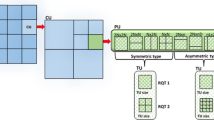Abstract
Video compression and decompression are an inevitable part of the multimedia applications. There is a need for effective algorithms that can reduce the bandwidth along with maintaining the perceptual quality of the images. H.264 is a video coding standard by ITU/T and ISO/IEC groups that fits the purpose. Design of H.264 decoder as an IP is developed using xilinx ISE design suite. Functional verification of the same is carried out in ISE simulator. The physical design of the decoder is carried out using OpenLANE synthesis and PR software using sky130nm PDK. The IP core dimensions are 148.57 mm length and 146.88 mm width. The end IP meets the timing constraints and is free from DRC and LVS errors.
Access this chapter
Tax calculation will be finalised at checkout
Purchases are for personal use only
Similar content being viewed by others
References
J.A.Y. Tan, P.R.A. Lai, S.K.T. Que, E.R. Lapira, R.T. Ricardos, K.H. Torrefranca, A modified video coding algorithm based on the H.261 standard, in TENCON 2003. Conference on Convergent Technologies for Asia-Pacific Region, Bangalore, India, Vol. 3 (2003), pp. 913–917. https://doi.org/10.1109/TENCON.2003.1273380
G. Raja, M.J. Mirza, Performance comparison of advanced video coding H.264 standard with baseline H.263 and H.263+ standards, in IEEE International Symposium on Communications and Information Technology (ISCIT 2004), Sapporo, Japan, Vol. 2 (2004), pp. 743–746. https://doi.org/10.1109/ISCIT.2004.1413814
G.J. Sullivan, T. Wiegand, Video compression—from concepts to the H.264/AVC standard. Proc. IEEE 93(1), 18–31 (2005). https://doi.org/10.1109/JPROC.2004.839617
T. Wiegand, G.J. Sullivan, G. Bjontegaard, A. Luthra, Overview of the H.264/AVC video coding standard. IEEE Trans. Circ. Syst. Video Technol. 13(7), 560–576 (2003). https://doi.org/10.1109/TCSVT.2003.815165
M. Vranjes, S. Rimac-Drlje, D. Zagar, Subjective and objective quality evaluation of the H.264/AVC coded video, in 2008 15th International Conference on Systems, Signals and Image Processing, Bratislava (2008), pp. 287–290. https://doi.org/10.1109/IWSSIP.2008.4604423
R. Mukherjee, I. Chakrabarti, S. Sengupta, FPGA based architectural implementation of Context-based adaptive variable length coding (CAVLC) for H.264/AVC, in IET International Conference on Information Science and Control Engineering 2012 (ICISCE 2012) (2012), pp. 1–4. https://doi.org/10.1049/cp.2012.2417
Y. Shi, K. Tokumitsu, N. Togawa, M. Yanagisawa, T. Ohtsuki, VLSI implementation of a fast intra prediction algorithm for H.264/AVC encoding, in 2010 IEEE Asia Pacific Conference on Circuits and Systems (2010), pp. 1139–1142. https://doi.org/10.1109/APCCAS.2010.5774925
C. Guanghua, W. Fenfang, M. Shiwei, VLSI implementation of CAVLC decoder for H.264/AVC video decoding, in 2007 International Symposium on High Density packaging and Microsystem Integration (2007), pp. 1–3. https://doi.org/10.1109/HDP.2007.4283628
T. Stockhammer, M.M. Hannuksela, T. Wiegand, H.264/AVC in wireless environments. IEEE Trans. Circ. Syst. Video Technol. 13(7), 657–673 (2003). https://doi.org/10.1109/TCSVT.2003.815167
B.B. Adikari, W.A.C. Fernando, H.K. Arachchi, K. Loo, A H.264 compliant stereoscopic video codec, in Canadian Conference on Electrical and Computer Engineering, Saskatoon, Sask (2005), pp. 1614–1617. https://doi.org/10.1109/CCECE.2005.1557292
Draft ITU-T recommendation and final draft international standard of joint video specification (ITU-T Rec. H.264/ISO/IEC 14 496–10 AVC, in Joint Video Team (JVT) of ISO/IEC MPEG and ITU-T VCEG, JVT G050 (2016)
Author information
Authors and Affiliations
Corresponding author
Editor information
Editors and Affiliations
Rights and permissions
Copyright information
© 2022 The Author(s), under exclusive license to Springer Nature Singapore Pte Ltd.
About this paper
Cite this paper
Revanoor, G., Prabhavathi, P. (2022). Design and Verification of H.264 Advanced Video Decoder. In: Raj, J.S., Kamel, K., Lafata, P. (eds) Innovative Data Communication Technologies and Application. Lecture Notes on Data Engineering and Communications Technologies, vol 96. Springer, Singapore. https://doi.org/10.1007/978-981-16-7167-8_38
Download citation
DOI: https://doi.org/10.1007/978-981-16-7167-8_38
Published:
Publisher Name: Springer, Singapore
Print ISBN: 978-981-16-7166-1
Online ISBN: 978-981-16-7167-8
eBook Packages: Intelligent Technologies and RoboticsIntelligent Technologies and Robotics (R0)




